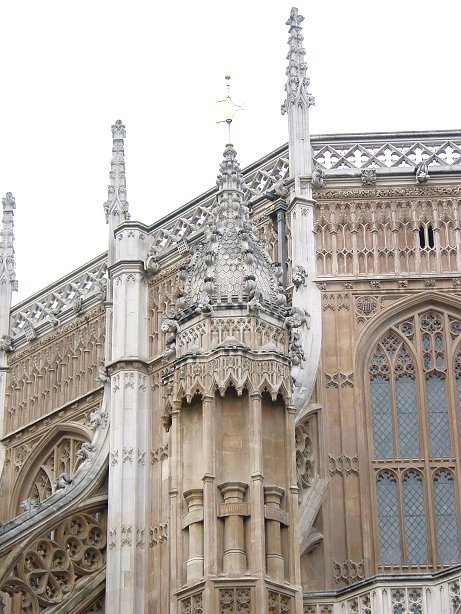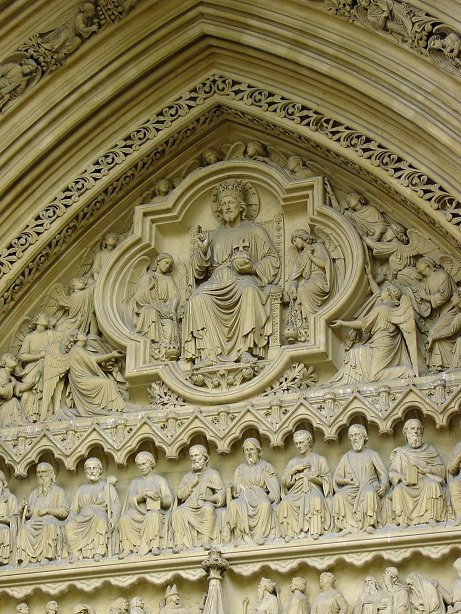
Horse Guards
and the Whitehall Area
Using the kind of persuasion that can come only from force, Henry VIII bought York Place north of Westminster Palace at an excellent price, then bought up much of the surrounding land. York Place, formerly owned by Cardinal Wolsey, was made into Whitehall Palace, the largest royal residence in England. Across the road from the main entrance, in the area just to the west, was built a tiltyard for jousting competitions and other entertainments. When Charles I became king, his policies toward Parliament created tension, and the tiltyard became home to a crude palace guardhouse. Fleeing Whitehall, Charles waged war on Parliament. He was defeated and eventually executed just outside Whitehall's Banqueting Hall. In 1660, his exiled son was invited back to rule as King Charles II. His safety was ensured by increased numbers of household troops, the guards, which evolved into the regular army. A new building, the "Old" Horse Guards, was built on the site of the palace guardhouse on the tiltyard. Stables for the horse guards were the dominate feature of the ground floor. The building evolved into army headquarters when General Monck, the Duke of Albemarle, took it upon himself to assume command of all troops - without any authority to do so.
In 1698 most of Whitehall Palace burned, reducing the Horse Guards' use as a royal gateway. The poorly designed building was allowed to decay and was replaced in the 1750s with the "New" Horse Guards building which still stands today with some modifications. It continued to serve some of the same functions, but army headquarters moved in the 1800s.

This is the view from across the road known as Whitehall, which passes through the site of the old palace. This is not the exact original look of the building as space was needed around 1800, and new additions were constructed on this side of the building. Pedestrians can pass between the two sentry posts and through the gate for most of the day, but with only a very few exceptions, most specifically for the queen, vehicles are not allowed to pass through the gate.
 |
 |
Just about everyone who comes to London takes pictures of the guards. These are mine.

Horse Guards Parade
This is the view from the other side also showing the Horse Guards Parade, which is on site of old tiltyard, and Admiralty House on the left, also known as the Old Admiralty Office. The buildings to the right are in the vicinity of Downing Street, famous as the Prime Minister's street. The king's carriage would pass through the Horse Guards gate when traveling to and from Whitehall, but this became less frequent over time until gradually it became such a tight fit that it became a real possibility that the carriage would become stuck. The room above the gate was used for courts martial, including the famed one for cowardice of Sir George Sackville for his actions at the 1759 battle at Minden here. The clock in the cupola above once had an unrivaled reputation for accuracy in London until the coming of Big Ben in the 1800s.
Behind the camera is St. James's Park, originally created by Henry VIII as a deer hunting park. St. James Palace is to the north of the park, and Buckingham Palace is to the west.

In an area once used for jousting, the parade was later used for drill. These gentlemen are facing the Navy building with the Horse Guards behind them to the right.

Admiralty House
At the north end of Whitehall is the Admiralty Arch, which the road passes through. To its right is the Old Admiralty Office.
 |
 |
 |
 |
Westminster Abbey
South of Horse Guards is Westminster Abbey, where many of the country's most famous figures are buried. Although heavily urbanized now, when the abbey was built, the area was rural. The lower right photo shows a display outside on November 11, 2003, the anniversary of the end of the First World War, with poppies prominent.

Jewel Tower
Just south of Westminster Abbey is the Jewel Tower, a remaining portion of the old Palace of Westminster. Parliament originally met wherever the king was located. Since the palace at Westminster was the most common royal residence, it eventually became by tradition the only place that Parliament met.

This model in the Jewel Tower is of St. Stephen's Chapel, the part of Westminster Palace in which Parliament met. The king eventually quit using the palace, so in 1547 the House of Commons was given the chapel.

Cromwell Statue at Parliament
After Parliament won the Civil War, Cromwell used the army to remove some members of Parliament, creating a "rump" Parliament and making himself a near dictator whose power was greater that that of the king he had helped depose and kill. Cromwell's son succeed him as "Lord Protector", but in 1660 Charles's son was asked to return to rule as Charles II. Needless to say, Cromwell was, and is, a controversial figure. The modern day English abhor revolution, so the problems of the mid 1600s, which perhaps explains why the term "Civil War" is used but not "Revolution". What the English actually call a "revolution", the Glorious Revolution, wasn't violent, but rather was the non-violent replacement of James II by a Protestant king more amenable to Parliament, which gained more power, especially over money - and therefore everything.

Despite the experience of "Civil War", freedom in the English speaking world continued to expand and endure, providing inspiration and assistance to oppressed people worldwide. In the modern Western world people are free to express even the most idiotic of ideas, even ones to the benefit of totalitarian governments which kill dissenters in their own countries with acid bathes and wood chippers. Not many centuries ago, people were too desperate to grow enough food to eat that they had no time to think up such foolishness. Perhaps the man in the mask feels guilty that he lives such an easy life. But the very freedom that many people fail to appreciate also allows self-righteous military history webmasters - who aren't as knowledgeable as they think they are - to digress from topic.


Parliament
The Palace of Westminster burned in 1834, and it was rebuilt in a somewhat controversial and odd style which has been vindicated over time. The building is popular with TV reporters, and we know they're never wrong.

Treasury
A major new Treasury building was built here between Horse Guards and Parliament by Kent in the 1730s. The below ground Cabinet War Rooms, a bunker complex built during the Second World War, is open to tourists with an entrance atop the steps on the left.
 Slim |
 At Guards Museum |
 Alanbrooke |
 Along Whitehall, November 11, 2003 |
Along Whitehall and surrounding vicinity are a number of statues and war memorials.

At the time of the webmaster's visit, the President was visiting also, prompting this thoughtful demonstration of Anglo-American respect and goodwill.
Back to John's Military History Tour of Britain